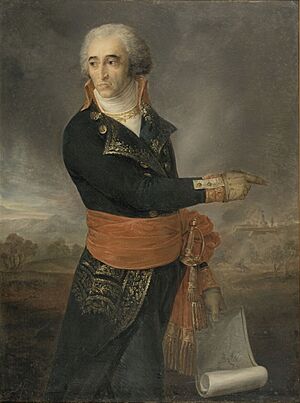François de Chasseloup-Laubat facts for kids
François Charles Louis, marquis de Chasseloup-Laubat (born August 18, 1754 – died October 3, 1833) was a famous French general and military engineer. He played a big role during the French Revolutionary and Napoleonic Wars. He was known for designing and building strong fortresses.
A Life in the French Army
François de Chasseloup-Laubat was born in a noble family in Saint-Sornin, France. He joined the French engineers in 1774.
When the Revolution began, he was still a junior officer. But his skills as a military engineer were quickly noticed in the wars of 1792 and 1793. The next year, he became a colonel. He was the chief engineer during the siege of Mainz in 1793. After that, he was sent to Italy.
Building Strong Fortresses
In Italy, he worked with Bonaparte's army, planning their positions and routes. He was promoted to brigadier-general. Later, he helped build new defenses along France's Rhine border.
His work as chief engineer for the army of Italy in 1799 was very successful. After the battle of Novi, he became a general of division. When Napoleon returned to lead the army in 1800, he chose Chasseloup again as his main engineer.
During the peaceful years from 1801 to 1805, Chasseloup-Laubat mostly rebuilt defenses in northern Italy. His most famous work was the huge fortress of Alessandria on the Tanaro River. He also worked on the famous Quadrilatero fortresses.
In 1805, he stayed in Italy with General André Masséna. But in 1806, Napoleon called him to join the main French army in Poland. There, he led the sieges of Colberg, Danzig, and Stralsund. During Napoleon's control of Germany, Chasseloup rebuilt many fortresses, including Magdeburg. In 1809, he served in Italy again.
Later Years and Legacy
In 1810, Napoleon made him a special advisor. His last military campaign was in Russia in 1812.
He soon retired from active duty. In 1814, he still helped with inspecting and building fortifications. King Louis XVIII made him a peer of France and a knight. Chasseloup-Laubat refused to join Napoleon during the Hundred Days (when Napoleon briefly returned to power). After the king returned, he voted against punishing Marshal Ney.
In politics, he supported the constitutional party, which believed in a government with a constitution. The king later made him a marquis. In his later years, Chasseloup-Laubat worked on organizing his writings, but his eyesight failed.
He was a skilled engineer who improved the old fortress designs. He added new features to make them even stronger.
His wife was the daughter of François Fresneau de La Gataudière. She brought him the Château de la Gataudière. His youngest son, Prosper de Chasseloup-Laubat, later became the Minister of the Navy under Napoleon III.


